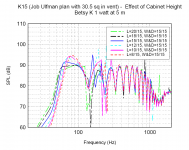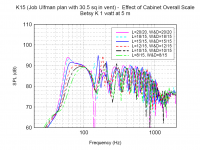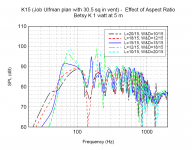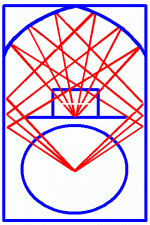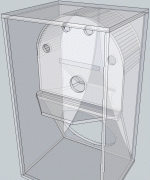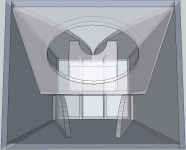fwiw, Carl Neuser almost always advocates a taller frontal aspect than the original. I don't have enough measured data to tell what it might do but assume in some cases may tune lower/ or avoid cavity peaking.
Some years back I had John Lapaire build a single K18, 22.5" wide, 16" deep, about 41.5" tall with a curved upper reflector and P=1/Q=1.7 (a bit faster than radial arc) aperture. A de-Q-ing slot extended the aperture to the top of the cabinet. An X15 K-tube was fitted. It turned out pretty well soundwise, good for many genre and despite an 18" woofer very good on vocals. It's ~groundplane shown below did not have much of a rise around 200.
I loaded it a couple of years ago with a 71g mms EVM18B and reduced the port area - its very lively.
X- what do you see in general on the Akabak sims as aspect becomes taller than JEK's original aspect?
Ken - if l live a few more years then will try that reflector idea
Some years back I had John Lapaire build a single K18, 22.5" wide, 16" deep, about 41.5" tall with a curved upper reflector and P=1/Q=1.7 (a bit faster than radial arc) aperture. A de-Q-ing slot extended the aperture to the top of the cabinet. An X15 K-tube was fitted. It turned out pretty well soundwise, good for many genre and despite an 18" woofer very good on vocals. It's ~groundplane shown below did not have much of a rise around 200.
I loaded it a couple of years ago with a 71g mms EVM18B and reduced the port area - its very lively.
X- what do you see in general on the Akabak sims as aspect becomes taller than JEK's original aspect?
Ken - if l live a few more years then will try that reflector idea
An externally hosted image should be here but it was not working when we last tested it.
An externally hosted image should be here but it was not working when we last tested it.
An externally hosted image should be here but it was not working when we last tested it.
An externally hosted image should be here but it was not working when we last tested it.
An externally hosted image should be here but it was not working when we last tested it.
An externally hosted image should be here but it was not working when we last tested it.
An externally hosted image should be here but it was not working when we last tested it.
An externally hosted image should be here but it was not working when we last tested it.
An externally hosted image should be here but it was not working when we last tested it.
Effect of Aspect Ratio on K15 Behavior
Freddi,
Here is a study of the effect of aspect ratio of the K-15 on the frequency response. I decided to examine it parametrically by:
(1) changing the cabinet height and keeping width and depth fixed - first plot;
(2) changing the overall cabinet scale by changing height, width and depth simultaneously in the same direction - second plot;
(3) changing the overall cabinet aspect ratio by changing height vs width and depth in opposite directions to get a skinny vs fat profile - third plot.
As you can see, you can achieve the best success by keeping the width and depth fixed while changing the cabinet height. When changing overall cabinet scale, going down to a 12/15 scale is almost as good as the original, but at 10/15 and below, the bass extension really suffers. Finally, on overall skinny vs fat, it appears that the proportions that Karlson came up with for the original is basically perfect - and deviating from that appears to drastically affect the performance from either too much bass peaking for squat (fat) cabinets, to depressed bass performance for a skinny implementation.
All simulations are based on the 1954 K15 plans as adpated by Job Ulfman with a 30.5 square inch vent and the Betsy K driver with the mic at 5 meters away and the speaker located 60 in away from a back wall. This is the 9 aperture Karlson slot AkAbak model (recall I did 14 apertures and there was little difference).
I hope this helps to explain the generalized effects of scaling a K15 cabinet without optimizing any other parameter.
Freddi,
Here is a study of the effect of aspect ratio of the K-15 on the frequency response. I decided to examine it parametrically by:
(1) changing the cabinet height and keeping width and depth fixed - first plot;
(2) changing the overall cabinet scale by changing height, width and depth simultaneously in the same direction - second plot;
(3) changing the overall cabinet aspect ratio by changing height vs width and depth in opposite directions to get a skinny vs fat profile - third plot.
As you can see, you can achieve the best success by keeping the width and depth fixed while changing the cabinet height. When changing overall cabinet scale, going down to a 12/15 scale is almost as good as the original, but at 10/15 and below, the bass extension really suffers. Finally, on overall skinny vs fat, it appears that the proportions that Karlson came up with for the original is basically perfect - and deviating from that appears to drastically affect the performance from either too much bass peaking for squat (fat) cabinets, to depressed bass performance for a skinny implementation.
All simulations are based on the 1954 K15 plans as adpated by Job Ulfman with a 30.5 square inch vent and the Betsy K driver with the mic at 5 meters away and the speaker located 60 in away from a back wall. This is the 9 aperture Karlson slot AkAbak model (recall I did 14 apertures and there was little difference).
I hope this helps to explain the generalized effects of scaling a K15 cabinet without optimizing any other parameter.
Attachments
It is to be expected to lose bass when going down in size. I don't think you can trade sensitivity for more bass as easily as with a simple reflex as I believe wavelength-related effects are at work. Scaling might thus not be the best way to do so ultimately. The small SK8 is 20" high, 12" deep and 13.5" wide when built with 0.75" material, for a 1.875cu.f external bulk. It's roughly a K10 if looking at the scale-down form K15, but has a higher back-to-front chamber ratio last time I checked. It can generate lots of power with good cone control with a fair reach below 100Hz. I'd call it solid down to 75-80Hz and more than what I'd expect from the graphs can still be heard and even felt below that. What's important IMO is that it gets low enough to meet a true woofer that'll take you down to 30-40Hz.
I might consider changing the FF225WK I've had in these for the past couple of years for some pro drivers, either Eminence Beta 8A or 8CX.
IG
I might consider changing the FF225WK I've had in these for the past couple of years for some pro drivers, either Eminence Beta 8A or 8CX.
An externally hosted image should be here but it was not working when we last tested it.
IG
if l live a few more years then will try that reflector idea
Perhaps we should do a little JEK style ray tracing and see if we can get
the curved reflectors to focus upon the angle plate? I'm counting on the
interferance pattern of the crashing wavefronts, but doesn't hurt to have
a synergy of helpful things going on.
If the K15 front shelf were turned sideways, how many degrees of arc
would each of the shelf side gaps appear to loudspeaker? And then if
it bounces cleanly off the sidewall, where exactly aboive that should
the kukoo clock reflectors be to recieve full illumination? What shape
to focus on the angle plate, or maybe upon slot center after bouncing
that angle???
No no no , focus on the top center of the shelf! That's the ticket...
If angle plate is 45deg, that puts our real focus on the front slot.
I gotta check that all the bounce angles look plausible and path
lengths about the same. Not saying they are, saying something
I definitely ought to check...
My existing drawing looks like the focus is way too high up in
the chamber for any synergy with the interference stripe exit
strategy. Maybe I can improve upon that...
If angle plate is 45deg, that puts our real focus on the front slot.
I gotta check that all the bounce angles look plausible and path
lengths about the same. Not saying they are, saying something
I definitely ought to check...
My existing drawing looks like the focus is way too high up in
the chamber for any synergy with the interference stripe exit
strategy. Maybe I can improve upon that...
Last edited:
hey X - those are very informative predictions -sk - question - with regular K15 size and 30.5 sq.in. vent, do you see Zmin at Fb occurring around 48Hz? Also, I've seen a near-cone measurement effect of a null around 37Hz at the center and bottom of a 15" speaker - what might explain that effect? - under 20vrms 36Hz sine drive, K15 seemed to have no more output than a reflex of K15's rear chamber sizes and overall tuning, but K15 had less than half the cone excursion.
a 12/15 size K15 could be good for several 8 and 10" fullrange speakers. I used to have such a thing but stupidly ditched it.
FE206EN is very good & lively in K12 size. I think some 8" fullrange, coaxial and woofer might use less rear chamber volume to gain more power handling.
factory K12 are around 0.74 scale - not very large. A good "K10" could be a lot of fun and potent for such a tiny cabinet.
dunno about the best reflector - the boundaries between the baffle and sidewalls could be made curved and concave with Bondo and a shaped scraper tool.
a 12/15 size K15 could be good for several 8 and 10" fullrange speakers. I used to have such a thing but stupidly ditched it.
FE206EN is very good & lively in K12 size. I think some 8" fullrange, coaxial and woofer might use less rear chamber volume to gain more power handling.
factory K12 are around 0.74 scale - not very large. A good "K10" could be a lot of fun and potent for such a tiny cabinet.
dunno about the best reflector - the boundaries between the baffle and sidewalls could be made curved and concave with Bondo and a shaped scraper tool.
I think we've found out, through K-builds of many sizes down to K5 and possibly K4 (has anyone built that?), that scaling linearly with driver size is not really the way to go. K12 should actually be a bit larger, as it is indeed ~1:0.75 down from K15 (thanks freddi - had forgotten) instead of 1:0.8, but is not bad as it is. Smaller sizes should hold back on the reduction factor. I think the factory K8 can be OK, but is likely a bit too compromised in the end, though I have never heard that size. The modern SK8 is actuall of K10 size if scalling down from K12 (so in my mind we do have a K10 around  ) or K9 if going from K15. It will probably perform better with a wider range of 8" drivers (within the typically prefered set of parameters) than K8 and could actually give a good account of certain 10", Beta 10CX comes to mind. In the end, you want a mass-corner frequency slightly above the front chamber tuning frequency. A Karlson is not a horn, but I think a similar approach is valid as the gain BW is wider than that of a simple reflex.
) or K9 if going from K15. It will probably perform better with a wider range of 8" drivers (within the typically prefered set of parameters) than K8 and could actually give a good account of certain 10", Beta 10CX comes to mind. In the end, you want a mass-corner frequency slightly above the front chamber tuning frequency. A Karlson is not a horn, but I think a similar approach is valid as the gain BW is wider than that of a simple reflex.
IG
IG
Last edited:
I've compared a couple of drivers in SK8, using my typical WinISD BP6 adapted simulation.
Fostex FF225WK - I have these in my pair right now
Celestion TF1020 10" midbass - I have these at home and yet to try in SK8
Eminence Beta 10CX - would like to try these sometimes
All three have acceptable response and I was mainly concerned with power handling to see just how loud each can get. Limiting cone excursion to each driver's Xmax figure for the excursion peak above Fb, they can each do:
FF225WK, 2.3mm : 20W input for 108dB @100Hz
TF1020, 2.0mm : 35W input for 110dB @100Hz
Beta 10CX, 5.0mm : 140W input for 118dB @100Hz
FF225WK might be at a disadvantage with less cone area and probably more power compression, which is not taken into account here. Still, it has the most low-end of all three and is thus likely to sound better small-signal. Its upper limit is more than enough for home use in any case IMO.
All three drivers can handle their above respective power levels down to ~50Hz before busting Xmax. I know Xmax can be a somewhat vague figure with no universal standard for specifying it, but I don't have anything else to go with.
IG
Fostex FF225WK - I have these in my pair right now
Celestion TF1020 10" midbass - I have these at home and yet to try in SK8
Eminence Beta 10CX - would like to try these sometimes
All three have acceptable response and I was mainly concerned with power handling to see just how loud each can get. Limiting cone excursion to each driver's Xmax figure for the excursion peak above Fb, they can each do:
FF225WK, 2.3mm : 20W input for 108dB @100Hz
TF1020, 2.0mm : 35W input for 110dB @100Hz
Beta 10CX, 5.0mm : 140W input for 118dB @100Hz
FF225WK might be at a disadvantage with less cone area and probably more power compression, which is not taken into account here. Still, it has the most low-end of all three and is thus likely to sound better small-signal. Its upper limit is more than enough for home use in any case IMO.
All three drivers can handle their above respective power levels down to ~50Hz before busting Xmax. I know Xmax can be a somewhat vague figure with no universal standard for specifying it, but I don't have anything else to go with.
IG
IG,
How are you modeling the SK8 in WinISD with a 6th order bandpass? Just volumes and vent dia and lengths - can you share your simulation input parameters? How close does it come to measured output - especially bass extension and SPL? I am surprised that the FF225WK has the lowest extension - the Beta 10CX is what I would have thought. That driver will make you deaf at 140 watts! I have some Texas Instruments TAS5630B class D amp IC's I have been thinking of building into a full amp that can produce 300 w/ch at 10% THD but at 150 watts/ch they are good for ~0.1% THD - perfect for blowing out your ears with low distortion!
A K15 with the Beta 10CX, a CD with K-tube or horn, or even mounted coaxially and a 150 watt can really jam at a party.
How are you modeling the SK8 in WinISD with a 6th order bandpass? Just volumes and vent dia and lengths - can you share your simulation input parameters? How close does it come to measured output - especially bass extension and SPL? I am surprised that the FF225WK has the lowest extension - the Beta 10CX is what I would have thought. That driver will make you deaf at 140 watts! I have some Texas Instruments TAS5630B class D amp IC's I have been thinking of building into a full amp that can produce 300 w/ch at 10% THD but at 150 watts/ch they are good for ~0.1% THD - perfect for blowing out your ears with low distortion!
A K15 with the Beta 10CX, a CD with K-tube or horn, or even mounted coaxially and a 150 watt can really jam at a party.
IG,
How are you modeling the SK8 in WinISD with a 6th order bandpass? Just volumes and vent dia and lengths - can you share your simulation input parameters? How close does it come to measured output - especially bass extension and SPL?
I try to use the actual rear and front chamber volumes based on plans. I cannot simulate a true K-slot, so use Ql=3 for the front chamber; seems to bring the upper bass peak down to measured levels. I do not set vent geometries but just input the tuning frequencies for already measured enlcosures, or the desired ones I'd then match at the build stage for prospective ones. WinISD won't take into accout the mass-loading effect of the front-chamber's air mass on the internal vent, so it tunes too high when using actual dimensions.
As for the second and highest tuning frequency, that of the front chamber in the BP model, I use a quarter-wave of ~90-95% of the internal chamber height, assuming a cabinet of traditional aspect ratio. Doing so for different geometries such as higher-aspect Karlsons (HAK) is not always as accurate.
I use these dimensions and tunings usually, rear-chamber and front-chamber respectively:
K15 - 110L@45-50Hz / 65L@115Hz
K12 (to matche the Karlsonettes I had) - 36L@60Hz / 25L@155Hz
SK8 - 24L@60-65Hz / 12L@200Hz
As mentionned above, I set Ql=3 for all front chambers. Here's what it looks like and I'll re-post a measurement of SK8 to compare.
An externally hosted image should be here but it was not working when we last tested it.
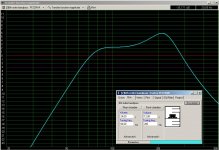
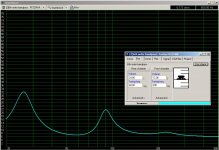
It is a limited and crude model , yes, but I think I've done it enough that I can get a fair enough idea of a specific driver's suitability for a given enclosure if nothing else. Goes without saying that this is good for the bass response only.
Plugging Beta 10CX in the K15 looks like it'd kick some serious butt with great low-end. I'm not surprised that FF225WK has the "best" low-end in SK8 versus the two 10" driver I compared, this has generally been the experience of K-users I believe. Perhaps a comparatively larger rear chamber volume and less cone area for the front chamber pressure to act on won't limit the LF output as much. The larger drivers will handle more power ultimately though and can probably take more EQ.
IG
Last edited:
IG,
That is pretty good to get even the bass fairly close in WinISD. I did not know you can set the Q of the cavity - where is that option located?
Under the Volume and Tuning freq. fields, click Advanced->. You have options to set Ql (leakage loss), Qa (absorbtion loss) and Qp (port loss).
IG
I have also done some simulation of a Karlson in Hornresp, where a top-vent device could be input as a tapped horn in the shape of a hourglass if you follow me. That turned out decent enough.
I've just thought of another way A Karlson could be done in HR, but for devices with vents somewhere closer to the driver. You want to set the rear chamber as vented, use the proper Vb and adjust the vent dimensions to yield the appropriate Fb. The front chamber can be modeled as an offset-driver horn (OD setting), with the speaker located somewhere close to the open end of the horn, perhaps 1/5 to 1/3. You can somewhat simulate the K-slot's expanding effect by having the horn chamber expanding from S0 to SL and match the Karlson's height in its length and front chamber volume in its Vb. SPL and Z plots are somewhat fairly representative, though I'd like to de-Q that upper-bass peak some more as I do in WinISD.
I'm not certain here if HR assumes the vent's output is coaxial with the horn output, but this could be the case and would work for vents located very close to the driver in a physical Karlson.
IG
I've just thought of another way A Karlson could be done in HR, but for devices with vents somewhere closer to the driver. You want to set the rear chamber as vented, use the proper Vb and adjust the vent dimensions to yield the appropriate Fb. The front chamber can be modeled as an offset-driver horn (OD setting), with the speaker located somewhere close to the open end of the horn, perhaps 1/5 to 1/3. You can somewhat simulate the K-slot's expanding effect by having the horn chamber expanding from S0 to SL and match the Karlson's height in its length and front chamber volume in its Vb. SPL and Z plots are somewhat fairly representative, though I'd like to de-Q that upper-bass peak some more as I do in WinISD.
I'm not certain here if HR assumes the vent's output is coaxial with the horn output, but this could be the case and would work for vents located very close to the driver in a physical Karlson.
IG
I'd like to know what a K-coupler with front chamber ~like X15 but rear chamber the volume of K15 does with similar tuning to K15 - IIRC, X15 has around 1CF front chamber
X15 dimensions
http://img203.imageshack.us/img203/383/8zhe.jpg
http://img834.imageshack.us/img834/3350/cy87.jpg
X15 dimensions
http://img203.imageshack.us/img203/383/8zhe.jpg
http://img834.imageshack.us/img834/3350/cy87.jpg
After some very rough ray-tracing, I submit this revised shape..
Real focus is the front slot, after hitting the 45deg washplate.
This way: Wether it works like a vertcal stripe of interfering
wavefronts, or JEK style rays as drawn here, either strategy
gets to the front slot and out with minimal reverb...
Not exactly whats shown in this old sketchup, but close...
Real focus is the front slot, after hitting the 45deg washplate.
This way: Wether it works like a vertcal stripe of interfering
wavefronts, or JEK style rays as drawn here, either strategy
gets to the front slot and out with minimal reverb...
Not exactly whats shown in this old sketchup, but close...
Attachments
Last edited:
on the small side, I've got a pair of K8-size couplers built by Art Welter's dad. They were roughly based on the 6-slit vent K12 and have a lot of vent area. Despite that, they tune about like JEK's 2-slot factory K8 from the mid 1960s.
That's a BetsyK in the K below - not the old paper surround Jensen - sound quality with BetsyK is pretty good and I would guess BG20 to work well too. A modest summed channel powered 10" Polk sub makes for good sound on theatre organ, etc. It would probably be better to use some highpass on the 8K's to relieve cone excursion at high levels.
Art's Dad's K8
Welter "K8" six-slot vent coupler with BetsyK vs a mid 1960's factory two-slot vent K8 with a Panasonic "metal" (whizzer - I believe) fullrange
That's a BetsyK in the K below - not the old paper surround Jensen - sound quality with BetsyK is pretty good and I would guess BG20 to work well too. A modest summed channel powered 10" Polk sub makes for good sound on theatre organ, etc. It would probably be better to use some highpass on the 8K's to relieve cone excursion at high levels.
Art's Dad's K8
An externally hosted image should be here but it was not working when we last tested it.
Welter "K8" six-slot vent coupler with BetsyK vs a mid 1960's factory two-slot vent K8 with a Panasonic "metal" (whizzer - I believe) fullrange
An externally hosted image should be here but it was not working when we last tested it.
Do we want a full sized washplate, or leave
room for a half moon or V cutout in the shelf?
Ignore the rest of this view for now, just
look at the shelf and washplate style as-if
they were grafted to the design above...
Which way might be better do you think?
Give the driver clear view of the full slot,
or give the upper chamber a cleaner exit?
---
I never got to try BetsyK. Mine come in the
mail open baffle Q Betsy. My order swapped
with Keantoken's, somehow he got the K's.
Those worked fine in his open baffle anyway.
room for a half moon or V cutout in the shelf?
Ignore the rest of this view for now, just
look at the shelf and washplate style as-if
they were grafted to the design above...
Which way might be better do you think?
Give the driver clear view of the full slot,
or give the upper chamber a cleaner exit?
---
I never got to try BetsyK. Mine come in the
mail open baffle Q Betsy. My order swapped
with Keantoken's, somehow he got the K's.
Those worked fine in his open baffle anyway.
Attachments
Last edited:
- Home
- Loudspeakers
- Full Range
- A Speaker that Kicks Butt in Large Spaces
